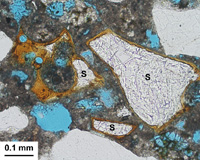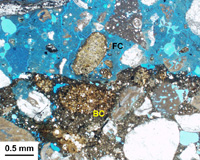
The term hardness is often used too casually to describe properties such as strength, permeability, and elasticity and this confuses an understanding of how different binders work in masonry construction. The photomicrograph shown here is from a late 19th century stone masonry mortar. The mortar was considered to be hard and it was suspected that the mix was rich in portland cement. Through petrography, we found that the binder consisted of a slag cement or a mix of lime and blast furnace slag (S). The dark reaction rims on the slag grains also caused the lime-rich mortar to have a dark appearance. In fact, the pozzolanic reaction did enhance the mortar’s strength. However, there is still a relatively high permeability and the mortar is significantly more elastic than a portland cement mortar. Portland cement based reformulations would not be advisable for the relatively soft sandstone masonry particularly as a repointing over the more porous lime-based setting bed mortar.

Another misconception is that all interior plasters before about 1890 were based on pure lime putty mixtures and after 1890, gypsum-based plasters became the norm. In fact, hydraulic limes were not uncommon as well as limes treated with sulfuric acid fumes to produce a type of gypsiferous lime. In the micrograph shown here, the mid-19th century plaster has a pure natural cement brown coat (BC) and a lime-based finish coat (FC) gauged with a small amount of natural cement. The cement brown coat affords good volume stability and moderate strength. The cement gauging in the finish coat provides some degree of surface hardness without detracting from the white color of the finish.
Historical Cements and Limes
Near the end of the 18th century, masons were limited to the same lime, gypsum, and earthen binder technology in use for millennia. Just over one hundred years later, the same materials we use to construct modern block and cavity wall structures are introduced into the marketplace. It might be natural to think that we went from lime technology to portland cement technology overnight. In fact, modern preservation literature is littered with this misconception. You may have heard that before the 1870’s, all buildings were constructed with sand-lime mortar and after that it is all portland cement. Nothing could be further from the truth and this erroneous timeline misses the rich and diverse technological history of the industrial revolution as our ancestors sought for better hydraulic binders to build more ambitious masonry structures.
During the late 18th and early 19th centuries, we see the development of natural hydraulic lime, high calcium Roman cement, dolomitic natural cement, selenitic lime, grappier cement, Sorel cement, slag cement and finally early incarnations of clinkered portland cement including the white varieties. It’s not until the late 19th or early 20th century that portland cement becomes consistent in quality due to the invention of the rotary kiln and lime is available as a packaged prehydrated powder.
What is interesting about modern masonry binders is that we see the blending of other materials with portland cement to produce mortars that are compatible with masonry construction. This is because the properties of portland cement are generally designed and continually improved for use in higher strength concrete construction. In contrast, the materials of the 19th century were designed specifically for masonry or stucco. It becomes important to identify these materials in historic mortars and stuccos as each binder has its own unique properties.
Hydraulic limes had the desirable properties of lime with the added benefit of earlier set and some increased strength. Though of limited use in the United States for masonry, they were popular where non-staining characteristics were important. The natural cements went under many names and saw many uses. Most were fast setting binders and high calcium European varieties were often used for castings. The American dolomitic cements were renowned for the use in brickwork due to excellent volume stability and watertightness. Their elasticity and chemical stability has given them long lasting durability. The Sorel cements were popular for manufacturing cast stone though other cements and blends are equally common. Slag cements were the modern 19th century version of the Roman pozzolanic binders. The degree of reactivity was highly variable resulting in mortars of wide ranging characteristics.
Designing replication mortars requires an understanding of the characteristics of historic binders and we have seen many examples of poor results where these are not understood. Highbridge has been an active participant in the renewed interest in these materials and we have become industry leaders in the identification and characterization of these diverse binders. For more information on how we identify historic binders, download our paper on distinguishing natural cement in historical masonry.




